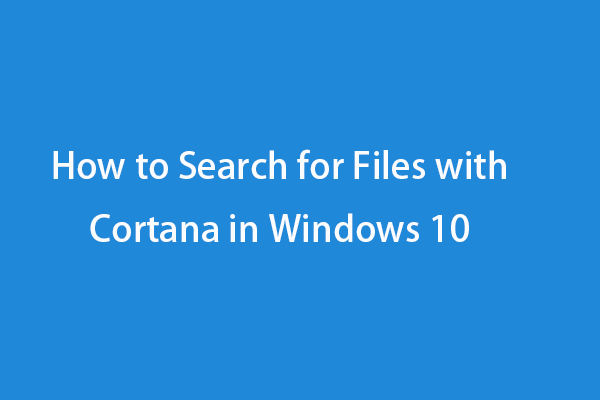
Introduction
Windows 10, Microsoft’s versatile operating system, comes equipped with a powerful search functionality that is seamlessly integrated with Cortana, the intelligent virtual assistant. This feature allows users to effortlessly locate files, documents, and applications on their devices, streamlining the digital experience. In this extensive guide, we will explore the significance of using Cortana for file searches in Windows 10, understand the capabilities of this search functionality, and provide a detailed tutorial on harnessing Cortana’s power to find files efficiently within the Windows 10 ecosystem.
Understanding the Importance of File Searches with Cortana
The ability to search for files with Cortana in Windows 10 is a pivotal aspect of user productivity and organization. As digital storage becomes more expansive and diverse, finding specific files or documents can be a time-consuming task. Cortana’s integration with the Windows search functionality transforms the process into a more intuitive and streamlined experience. By harnessing the power of Cortana, users can access a sophisticated search engine that combines voice commands, natural language processing, and deep file indexing to locate information swiftly and accurately.
The Advantages of Searching for Files with Cortana
- Efficiency and Time-Saving: Cortana’s file search capabilities significantly reduce the time and effort required to locate specific files. With natural language processing, users can articulate their search queries in a way that feels conversational.
- Voice-Activated Convenience: Cortana allows users to perform file searches using voice commands, providing a hands-free and convenient way to access information. This feature is particularly useful for users with mobility challenges or those who prefer a voice-centric interaction.
- Deep File Indexing: Cortana, integrated with the Windows search functionality, employs deep file indexing to ensure comprehensive coverage. This means that the virtual assistant can locate files across various storage locations, including local drives, external devices, and cloud storage.
- Personalization and Customization: Cortana tailors search results based on the user’s preferences, frequently accessed files, and contextual relevance. This personalized touch ensures that the search experience aligns with the user’s individual needs and habits.
Step-by-Step Guide: Searching for Files with Cortana in Windows 10
Now, let’s delve into the detailed process of searching for files with Cortana in Windows 10:
Step 1: Activate Cortana
Ensure that Cortana is activated on your Windows 10 device. Click on the Cortana icon on the taskbar, or press the Windows key and start typing to activate the virtual assistant.
Step 2: Start a File Search
Initiate a file search by using voice commands or typing queries into the Cortana search bar. For example, you can say, “Hey Cortana, find my recent documents,” or type, “Documents from last week.”
Step 3: Refine Your Search
To narrow down search results, utilize keywords, file names, or specific time frames. For instance, you can say, “Show me photos from January,” or type, “Presentation slides for project X.”
Step 4: Utilize Natural Language Queries
Cortana’s natural language processing capabilities allow users to use conversational queries. You can ask, “Where is the spreadsheet I worked on yesterday?” and Cortana will interpret and provide relevant results.
Step 5: Access Filters and Sorting Options
Cortana offers filters and sorting options to refine search results further. You can click on the filters provided or use specific terms like “type: document” or “date: this month” in the search bar.
Step 6: Pin Important Files
For frequently accessed files, consider pinning them to the Start menu or taskbar for quick access. Right-click on a file in the search results and select “Pin to Start” or “Pin to taskbar.”
Step 7: Leverage Voice Commands for Quick Access
Cortana’s voice commands extend beyond traditional searches. You can use voice commands like “Open my recent documents” or “Show files from last week” for quick access to specific types of files.
Step 8: Explore Advanced Search Features
Windows 10 offers advanced search features that can be accessed directly through Cortana. Type specific search parameters like “author:” or “tag:” to narrow down results based on file metadata.
Step 9: Review Search Suggestions
As you type your search query, Cortana provides suggestions in real-time. Review these suggestions for quick access to files or to refine your search based on the available options.
Step 10: Access Search History (Optional)
If you need to revisit recent searches, you can access your search history by clicking on the search bar and selecting from the dropdown list of recent queries.
Considerations and Tips
- Indexing Time: File searches with Cortana rely on Windows search indexing. Allow some time for the system to index new files, especially after significant changes or additions to your file storage.
- Windows Updates: Cortana’s capabilities may evolve with Windows updates. Keep your operating system up to date to access the latest features and improvements.
- Cloud Storage Integration: Cortana can search for files stored in cloud services like OneDrive. Ensure that your cloud storage is integrated and synced with your Windows 10 device for comprehensive search results.
- Privacy Settings: Customize Cortana’s access to files and personal data through privacy settings in Windows 10. Adjust these settings based on your preferences for data protection.
Conclusion
Searching for files with Cortana in Windows 10 is a transformative aspect of the digital experience, offering users an efficient, voice-activated, and personalized approach to file retrieval. By following the comprehensive step-by-step guide provided in this overview, users can seamlessly integrate Cortana into their file search routine, streamlining the process and enhancing overall productivity within the Windows 10 ecosystem. As technology continues to advance, features like Cortana exemplify Microsoft’s commitment to creating a user-centric operating system that leverages intelligent virtual assistants to simplify and enrich everyday interactions. Embrace the power of Cortana for file searches, and let the virtual assistant navigate your digital realm with precision and ease.